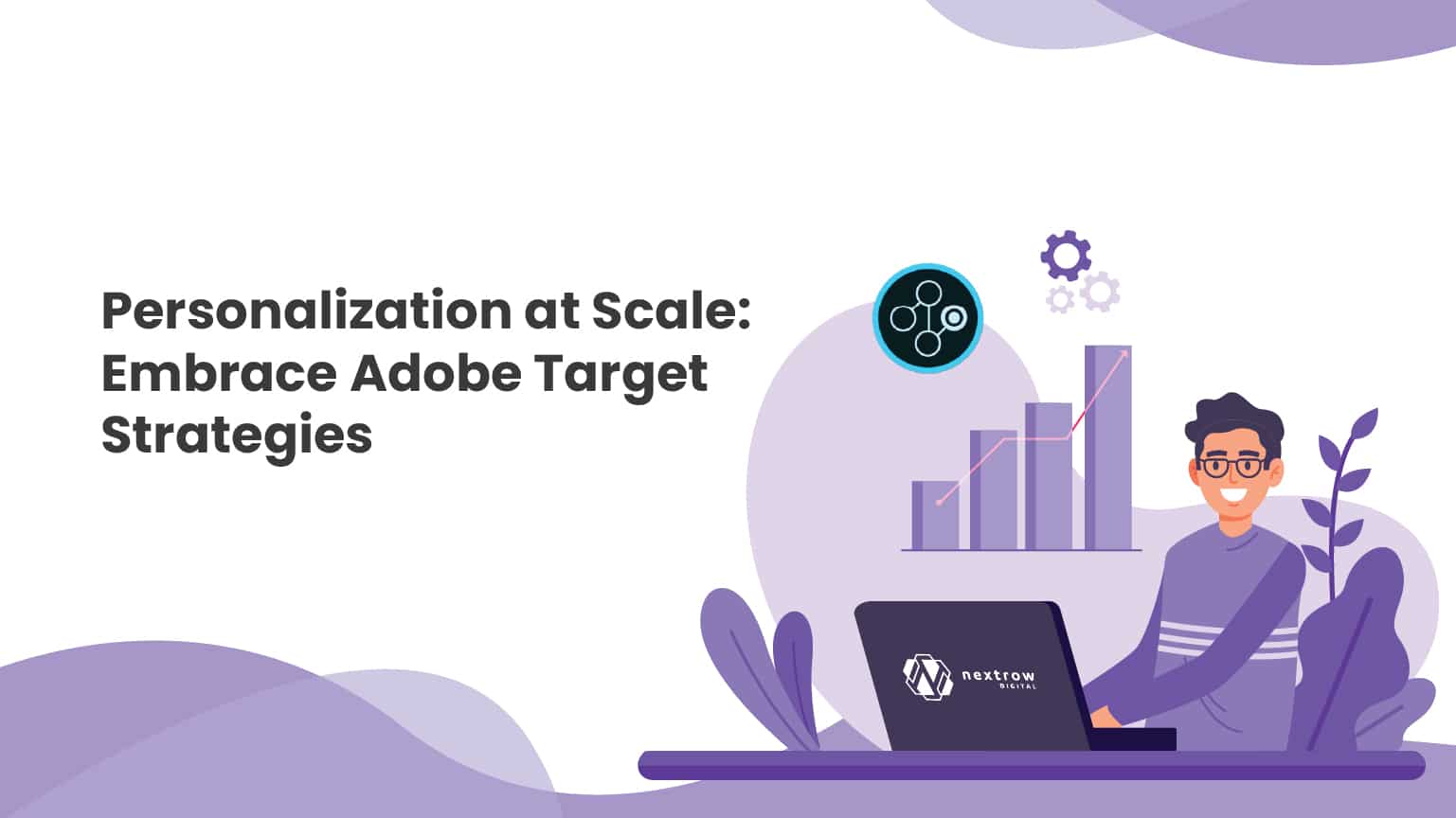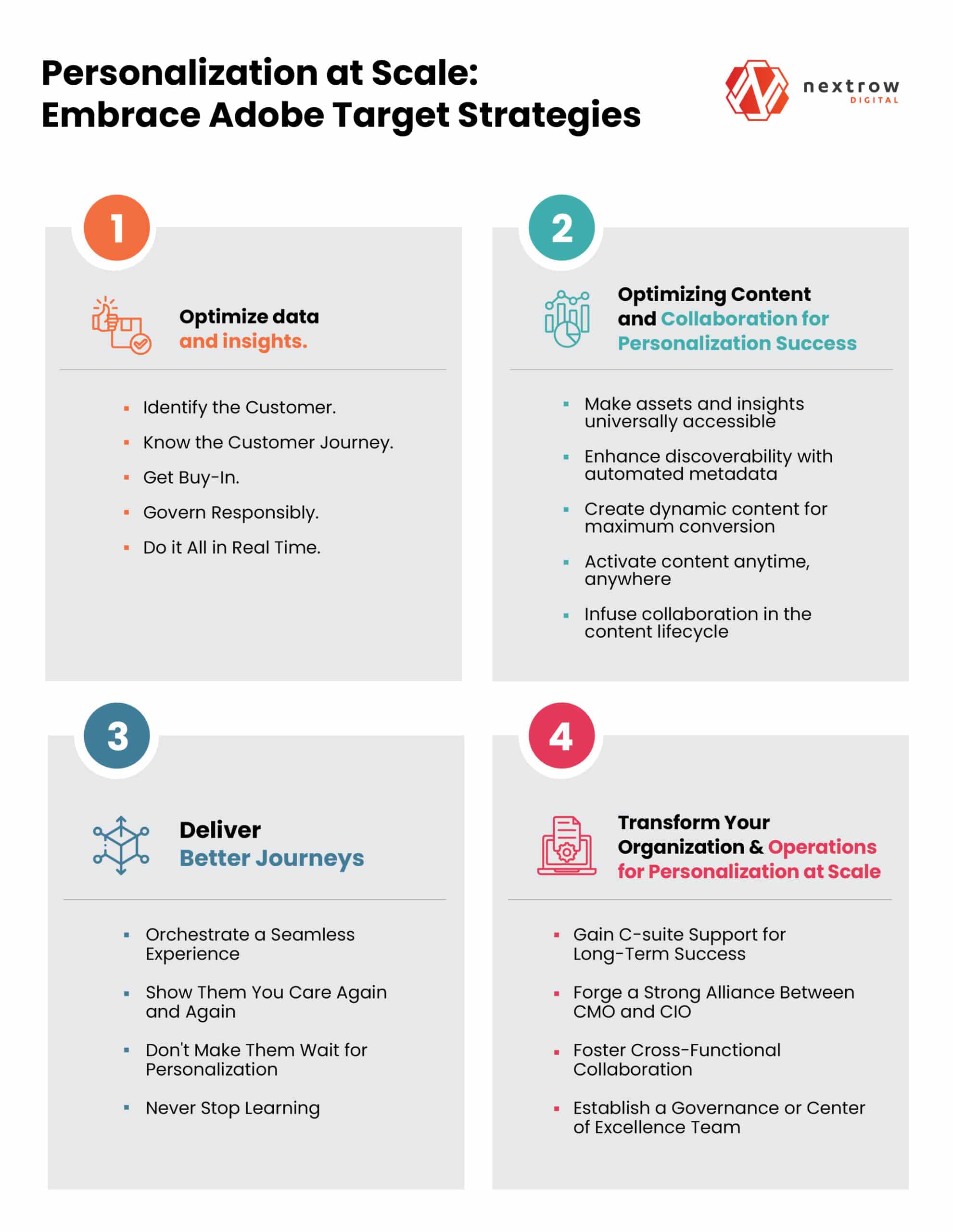
In our previous blog we explored the world of personalization at scale with Adobe Target powered by AI. We learnt how to elevate customer engagement intelligently. Moreover, we understood how NextRow experts can guide you through challenges, harness data, and create seamless personalized journeys and how to make digital more personal with Adobe Target services. Now is the time to go ahead and know the four-strategies on which personalization at scale hinges. Let’s scroll the blog to know our answer!
Before that if you’re crafting your personalization plan keep these principles in focus:
- Make your data actionable—it’s built for action.
- Instill trust by letting value lead every interaction.
- Ensure a seamless journey with no breaks.
- Understand the context behind every move.

Strategy 1: Optimize data and insights.
In today’s dynamic business landscape, scaling personalization requires a strategic investment in a robust data and insights platform. This platform should seamlessly integrate customer experience data from various channels into a unified model, ensuring real-time delivery of optimal experiences. The days of scattered data across different platforms are gone; now, it’s crucial to centralize data in a flexible, unified model for effective targeting and personalization.
a) Identify the Customer.
- Integrate data from all communication channels to create a unified customer profile.
- Enable the integration of customer and account profiles with other experience technologies.
- Build and activate profiles in real time on relevant platforms.
b) Know the Customer Journey.
- Gain a comprehensive understanding of the customer journey across all channels.
- Utilize technology to collect, combine, query, and visualize data in real time.
- Leverage AI to improve the speed of acting on customer insights, a critical aspect often overlooked by businesses.
c) Get Buy-In.
- Establish a first-party data foundation to reduce dependence on third-party cookies.
- Emphasize the importance of customer retention as acquisition costs are expected to rise.
- Utilize first-party data to personalize experiences, enhance customer loyalty, and inform strategic decisions.
d) Govern Responsibly.
- Acknowledge the responsibility to protect customer data and deliver meaningful experiences.
- Implement a data governance framework to ensure privacy rules are consistently applied.
- Address the challenge of managing and enforcing data usage appropriately.
e) Do it All in Real Time.
- Integrate technology systems into a cohesive martech stack for improved customer experiences.
- Achieve a seamless flow of data to minimize latency and disjointed experiences.
- Emphasize the importance of real-time processing for delivering personalized customer experiences in milliseconds.
Pro Tip: Investing in these key aspects ensures a data-driven approach to personalization, setting the stage for enhanced customer experiences and a competitive edge in the market.
Strategy 2: Optimizing Content and Collaboration for Personalization Success
To truly connect with customers on a personal level, you must offer them something valuable—be it a coupon, an informative guide, a how-to video, or a downloadable link. This valuable offering revolves around content. Leveraging customer experience data, you can craft, deliver, and refine personalized content tailored to specific market segments. However, achieving this level of personalization requires a robust content production machine that seamlessly integrates every stage of the content lifecycle.
a) Make assets and insights universally accessible
As you scale your content for personalization, efficient creative asset management becomes crucial. With a myriad of assets available, ranging from logos to videos, finding the right message becomes challenging. A centralized content hub accessible to all teams ensures quick access to the necessary content. This hub should also incorporate version control, ensuring everyone uses the latest and most effective assets, thereby driving cost savings.
b) Enhance discoverability with automated metadata
Establishing an organized hub involves populating metadata automatically, minimizing wasted efforts and redundant work. By keeping insights open to everyone, teams can measure content performance at the asset level, gaining valuable insights that inform future content creation.
c) Create dynamic content for maximum conversion
The goal of content is conversion. AI enables the creation of dynamic content that adapts in real time to customer actions, behaviors, and needs. Personalize email content, tailor promotional offers, and serve customized content blocks on landing pages based on customer preferences or past purchases. Implement behavior-triggered notifications, such as in-store promotions, through SMS.
d) Activate content anytime, anywhere
After assembling dynamic content, the next step is delivering it to the right destination—website, mobile app, social media, digital sign, IoT devices, etc.—at the precise moment the customer desires it. Activating the most relevant content at the perfect occasion transforms engagement into profits. Empower your content production machine with technology to deliver dynamic content in real time via API across the entire customer journey.
e) Infuse collaboration in the content lifecycle
With the hybrid work model becoming a permanent fixture, collaboration needs new modes. A work management system connects projects to strategic imperatives, allowing teams to collaborate from anywhere. Centralizing work provides every team member with a comprehensive view from strategy to results, fostering clarity and agility. Integration with creative tools accelerates work velocity without compromising compliance or quality standards.
Are you crafting your personalization plan?
Strategy 3: Deliver Better Journeys
Customers today encounter brands through various channels, from stores and online platforms to apps, emails, and social media. Navigating these channels requires marketers to orchestrate seamless and personalized experiences throughout the entire customer lifecycle.
a) Orchestrate a Seamless Experience
Coordinating customer journeys in real time across multiple channels is crucial for sustained engagement. Omnichannel orchestration, the ability to create cohesive experiences across web, mobile, email, chat, SMS, and more, ensures customers seamlessly transition between interactions. Managing personalized omnichannel journeys becomes complex with diverse tools, but a unified interface simplifies the process. This allows for real-time personalized interactions and scheduled audience-based messages from a single platform, catering even to non-technical users.
b) Show Them You Care Again and Again
Building customer loyalty involves continuous personalized interactions. From the first interaction, maintaining a personalized approach for guests, subscribers, buyers, and others throughout their lifecycle is essential. Leveraging technology, such as a customer data platform (CDP), provides a comprehensive view of the customer journey. This platform integrates data securely, incorporates AI for segmentation, orchestrates marketing messages, and guides customers through both physical and digital channels.
c) Don’t Make Them Wait for Personalization
Given the average person’s eight-second attention span, reacting to behavioral data in real time is crucial for delivering better journeys. AI and machine learning come into play here, predicting customer actions and providing personalized recommendations and content at scale. Speed is the essence, and leveraging technology allows brands to meet customer expectations promptly.
d) Never Stop Learning
To refine personalized experiences, A/B/n testing is indispensable. This method, testing multiple variations of content and experiences, helps identify what resonates best with customers. Choosing a testing tool that accommodates numerous variations and includes a visual experience editor streamlines the testing process. Continuous learning from testing outcomes enhances key performance indicators and overall business outcomes.
Strategy 4: Transform Your Organization and Operations for Personalization at Scale
Achieving personalization at scale requires a strategic overhaul of your organization and operational capabilities.
a) Gain C-suite Support for Long-Term Success
Personalizing the customer journey for millions demands time and commitment. Building capabilities across channels is a journey that might span years. The critical factor here is top-down support from C-suite executives. These leaders play a pivotal role in aligning strategies with enterprise business goals, securing funding, and advocating for organization-wide transformation.
b) Forge a Strong Alliance Between CMO and CIO
The synergy between Chief Marketing Officers (CMOs) and Chief Information Officers (CIOs) is the linchpin of successful personalization. CIOs are the architects of the technology enabling personalization, while CMOs craft personalized experiences powered by that technology. A close partnership between these leaders ensures agility in adapting to evolving customer expectations and needs. A shared vision translates into more creative, agile, and innovative customer experiences.
c) Foster Cross-Functional Collaboration
Effective collaboration must extend beyond the C-suite and permeate throughout the organization. Unfortunately, recent surveys reveal a gap in collaboration between marketing and IT teams. Senior executives and their teams need to work collaboratively to execute personalization strategies. Regular check-ins, open communication, and breaking down silos are essential. According to Adobe’s 2022 Digital Trends report, 65% of senior executives feel there is more work to be done to break down silos created by organizational structures and competing KPIs.
d) Establish a Governance or Center of Excellence Team
Empower a dedicated team of business and tech executives to spearhead your digital transformation. This governance or center of excellence team takes charge of mapping out the strategy, prioritizing capabilities, developing a business case, and crafting a step-by-step implementation plan. They are instrumental in restructuring business processes and identifying organizational changes required to usher in personalization at scale.
Final Words
Learn how NextRow lets you deliver personalized experiences to each customer with Adobe Target Services! We provide Personalize and optimize customer experiences with Adobe Target. Roll out the best-tailored experiences to the audience with A/B testing, multi variance testing, user behavior, and personal recommendations with our proven strategies.
Got Questions on NextRow Strategies for Adobe Target?
Get In Touch
Driving business growth by transforming challenges into opportunities with innovative, tailored solutions that deliver measurable results.

